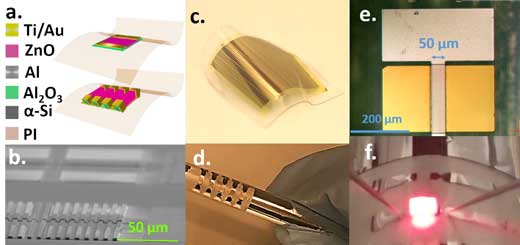| Posted: Nov 14, 2017 | |
Thin-film transistors get wavy |
|
| (Nanowerk Spotlight) For enhanced visualization experience, high resolution (>300-500 pixels per inch) display technology with fast frame rate (>240 Hz) to suppress the motion blur at that resolution is essential. | |
| In modern display technologies, which are mostly active matrix display system, there are planar thin film transistors (TFTs) which enable both high resolution and fast imaging. Scaled TFTs can provide high resolution. Fast switching can be facilitated by the scaling as well as high mobility channel material. | |
| Unfortunately, although amorphous oxide semiconductors with modest mobility are predominantly used in TFTs, their scaling is expensive and their scaled version suffers from short channel effect. | |
| "Therefore, by embracing a novel – wavy – architecture of non-planar vertical fin arrays, which are also laterally connected to each other, we have shown enhanced transistor performance (×2) due to 70% more width (directly proportionate to output current) without any area penalty (because they are vertically oriented)," Muhammad Mustafa Hussain, an Associate Professor of Electrical Engineering at King Abdullah University of Science and Technology (KAUST), tells Nanowerk. "Using commonly used amorphous oxide zinc oxide (ZnO) as active channel material with a low thermal budget integration sequence, they have demonstrated wavy architecture TFT array on physically flexible soft polymer." | |
| As Hussain and his team report in Small ("Wavy Architecture Thin Film Transistor for Ultra-High Resolution Flexible Display"), by using a low thermal budget process integration sequence only, they have shown both high resolution and fast frame rate display technology is possible, irrespective of the active channel material. | |
| Additionally, in wavy TFTs, they observed suppressed short channel effects, higher threshold voltage stability compared to status-quo. The current demonstration decisively proves enhanced visualization experience will be realized in near future for high resolution display technology. | |
 |
|
| a) 3D schematic of coplanar and wavy channel thin film transistors (TFTs) on a flexible substrate. b) Side view SEM of planar(top)and wavy channel (bottom) TFTs. c) Digital image of peeled-off TFTs which is transferred on a PDMS substrate, and d) flexible LEDs substrates showing flexibility down to 5 mm bending radius. Digital images of a e) planar TFT having Lg = 50 µm and W = 240 µm and a f) flexible red LED under forward. (click on image to enlarge) | |
| By demonstrating this wavy transistor array on a soft polymeric platform using a low temperature process, the researchers have shown LEDs lighting brighter without increased power consumption. | |
| In the past, vertically oriented non-planar fin arrays have been used for high performance computation purpose. But the fins have been isolated. The KAUST team has for the first time shown joined fins and in TFT architecture. | |
| "For high resolution display technology used for infotainment and small gadgets, including point-of-care diagnostic devices, our wavy TFTs can be used," says Hussain. "But more importantly, a disruptive design would be possible to transition to flexible display technology from status-quo of rigid display technology." | |
| The next stages of the team's work will include demonstration of various flexible display related applications, which are not possible with today's rigid display. They are already working on demonstration of a computation device which can be flexed. | |
 By
Michael
Berger
– Michael is author of three books by the Royal Society of Chemistry:
Nano-Society: Pushing the Boundaries of Technology,
Nanotechnology: The Future is Tiny, and
Nanoengineering: The Skills and Tools Making Technology Invisible
Copyright ©
Nanowerk LLC
By
Michael
Berger
– Michael is author of three books by the Royal Society of Chemistry:
Nano-Society: Pushing the Boundaries of Technology,
Nanotechnology: The Future is Tiny, and
Nanoengineering: The Skills and Tools Making Technology Invisible
Copyright ©
Nanowerk LLC
|
|
|
Become a Spotlight guest author! Join our large and growing group of guest contributors. Have you just published a scientific paper or have other exciting developments to share with the nanotechnology community? Here is how to publish on nanowerk.com. |
|
